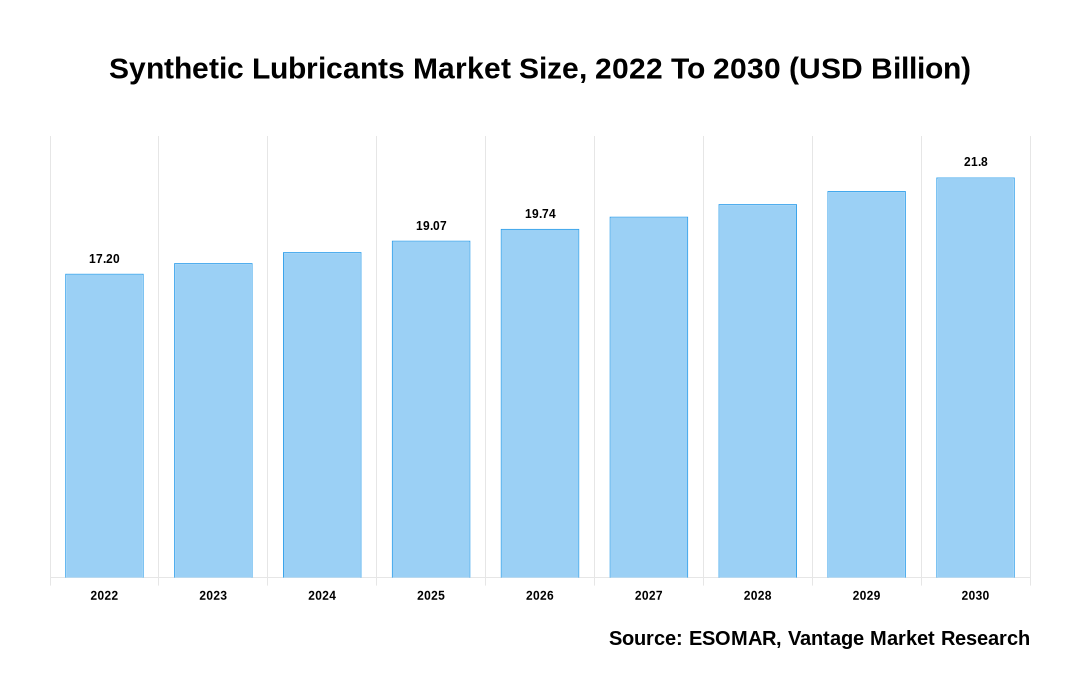Global Synthetic Lubricants Market
As stated in our extensive report; the Global Synthetic Lubricants Market accounted for USD 17.2 Billion in the year 2022 and is forecast to reach USD 21.88 Billion by 2030 at a CAGR of 3.5%.
Synthetic Lubricants, such as esters and Poly Alpha Olefin (PAO), are lubricants produced from synthetic base oils that take the place of mineral oil sourced from crude oil. Over the anticipated period, the demand for Synthetic Lubricants is expected to rise due to factors like an increase in the number of vehicles on the road, increased environmental regulations in the automotive industry to cut emissions and rising industrialization in emerging economies. An in-depth analysis of the market is provided in the study on the global Synthetic Lubricants market.
Click To Get a Free Sample On the Research Study

The lubricant decreases the temperature of the moving parts by absorbing heat that is emitted from the mechanical parts, extending the equipment’s overall operational life. Many beneficial characteristics of Synthetic Lubricants include their low energy requirements, high thermal and oxidative stability, volatility, and flash points. Because of this, they are widely used in a variety of industries, such as construction, mining, oil and gas, textile, food processing, chemical, and automotive.
Lubricants are chemicals that are used to lessen friction between two sliding or moving surfaces. To lessen the material deterioration brought on by friction, the lubricant’s primary goal is to distinguish between the two sliding or moving surfaces. Thickeners, synthetic base oils, and additives make up Synthetic Lubricants. In terms of advantages, they compare favorably to different mineral-based lubricants. They are typically categorized as oily and liquid substances that are not made from petroleum but have qualities that are comparable to those of lubricants made from petroleum. By absorbing the heat created by moving vehicle parts and sending it to the sump or cooler, these lubricants assist in controlling temperature.
Key factors influencing Synthetic Lubricants Market Growth
The growth of the global Synthetic Lubricants market can be attributable to the following:
- Mineral lubricants are inferior to Synthetic Lubricants because of their inferior hardware compatibility with automobile components, among other advantages.
- Increasing demand in the Asia Pacific due to increased auto production and the installation of new machinery is also anticipated to boost demand for the good.
- The demand for Synthetic Lubricants is increasing as a result of technological developments like the NSF Food Lubricants standard, which was established for the use of Synthetic Lubricants by significant equipment builders in the food sector.
- The market’s expansion is anticipated to be hampered by consumer preference for less expensive Synthetic Lubricants.
- The use of Synthetic Lubricants will likely become less common as the demand to save maintenance costs in the manufacturing sector grows.
- Future market expansion is anticipated to be hampered by the incompatibility of conventional mineral oils and polyethylene glycol (PAG)-based oils with polyalphaolefins (PAOs).
Asia Pacific Region to Lead the Market
In 2022, Asia Pacific dominated in terms of revenue share. This increase is due to the rising petrochemical and automotive industries in the area. The Synthetic Lubricants market is dominated by a few large oil companies that manufacture Synthetic Lubricants and have wide distribution networks. Because of the region’s rising petrochemical output, the Asia Pacific refinery industry, especially in countries like China, India, and Singapore, has benefited from the low price of crude oil.
Europe is another region where the market is expanding quickly. Its expansion is ascribed to a number of things, including the region’s recovering industrial sector, increased emphasis on lowering vehicle CO2 emissions, improvements in product quality, and base oil availability. Demand for the product is also being fueled by rising investment in synthetic lubricant blending facilities in Russia and the Netherlands. Yet, the market may be threatened by the rules and regulations established by the European Union for the protection of human health and the environment.
Due to rising demand from the engine oil application category, the supply of Synthetic Lubricants in North America is also anticipated to increase. Because of the expansion of the automobile industry in the area, the supply of engine oil is increasing. Because they provide improved thermal stability and a reduction in friction resistance, Synthetic Lubricants are necessary as functional consumables. As a result, each of these elements is influencing the region’s growth.
Conclusion
The Growing Automotive Industry and Industrialization across the Globe Driving the Synthetic Lubricants Market.
Some of the key players in the Global Synthetic Lubricants market include- BP Lubricants Pvt. Ltd. (India), Chevron Corporation (U.S.), LANXESS (Germany), Valvoline (U.S.), FUCHS (Germany), Pennzoil (U.S.), Phillips 66 Company (U.S.) and others.
![[Market Research Reports] – Research Google News Blog | VMR.Biz](https://www.vmr.biz/wp-content/uploads/2022/12/logo-removebg-preview.png)











